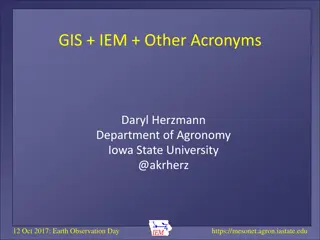Understanding Coordinate Systems, Map Projections, and GIS Applications
Explore the intricacies of Geographic Coordinate Systems, Projected Coordinate Systems, and different types of map projections as part of the Remote Sensing and GIS Application course taught by Lecturer Ruba Yousif Hussain in the third year. Dive into the properties of map projections like conformance, direction preservation, equidistance, and equal area. Learn about important projections like Universal Transverse Mercator (UTM) and the significance of datums in representing the Earth's surface accurately.
Download Presentation

Please find below an Image/Link to download the presentation.
The content on the website is provided AS IS for your information and personal use only. It may not be sold, licensed, or shared on other websites without obtaining consent from the author. Download presentation by click this link. If you encounter any issues during the download, it is possible that the publisher has removed the file from their server.
E N D
Presentation Transcript
Remote Sensing and GIS Application Lecturer Ruba Yousif Hussain Third Year 1
Remote Sensing and GIS Application Lecturer Third Year Ruba Yousif Hussain Coordinate Systems and Map Projections There are two types of coordinate systems -Geographic Coordinate Systems -Projected Coordinate Systems Because the shape of the earth is approximately spherical, locations on the earth's surface are often described in an angular coordinate or geographical system, with latitude and longitude specified in degrees ( ) , minutes (') , and seconds (") . Unfortunately, the calculation of distances and areas in an angular coordinate system is complex. More significantly, it is impossible to accurately represent the three dimensional surface of the earth on the two-dimensional planar surface of a map or image without introducing distortion in one or more of the following elements: shape, size, distance, and direction. Thus, for many purposes the geographical coordinates are transformed to a planar, or Cartesian (X-Y) ( Projected coordinate system ) . The result of this transformation process is referred to as a map projection. 2
Remote Sensing and GIS Application Lecturer Third Year Ruba Yousif Hussain Types of Map projections Map projections include cylindrical , conic , and azimuthal or planar surfaces. Figure 1 3
Remote Sensing and GIS Application Lecturer Third Year Ruba Yousif Hussain Properties of map projection A conformed map projection preserves angular relationships, or shapes, within local areas; over large areas, angles and shapes become distorted. An azimuthal (or zenithal) projection preserves absolute directions relative to the central point of projection. An equidistant projection preserves equal distances, for some but not all points. scale is constant either for all distances along meridians or for all distances from one or two points. An equal-area (or equivalent) projection preserves equal areas. Important Map projections Universal Transverse Mercator ( UTM ) UTM is an international plane (rectangular) coordinate system developed by the US Army that extends around the world from 84 N to 80 S. The world is divided into 60 zones each covering six degrees longitude. Each zone extends three degrees eastward and three degrees westward from its central meridian. Zones are numbered consecutively west to east from the 180 meridian. Figure 2 shows UTM Grid Zones of the World. 4
Remote Sensing and GIS Application Lecturer Third Year Ruba Yousif Hussain Dadum A datum is a mathematical definition of the three-dimensional solid (generally a slightly flattened ellipsoid) used to represent the surface of the earth. The actual planet itself has an irregular shape that does not correspond perfectly to any ellipsoid. As a result, a variety of different datums have been described, some designed to fit the surface well in one particular region and others designed to best approximate the planet as a whole. Most of the world has adopted the World Geodetic System of 1984 ( WGS 1984 ) The geoid is defined as the surface of the earth's gravity field , which is approximately the same as mean sea level. It is perpendicular to the direction of gravity pull. Since the mass of the earth is not uniform at all points, and the direction of gravity changes, the shape of the geoid is irregular. To simplify the model, various spheroids or ellipsoids have been devised. A spheroid or ellipsoids is a three-dimensional shape created from a two- dimensional ellipse. The ellipse is an oval , with a major axis (the longer axis) and a minor axis (the shorter axis). If you rotate the ellipse, the shape of the rotated figure is the spheroid. 5
Remote Sensing and GIS Application Lecturer Third Year Ruba Yousif Hussain Example Spheroid Clarke 1880 GRS80 1980 WGS84 1984 Semimajor axis (m) 6378249.145 6378137 6378137 Semiminor axis (m) 6356514.869 6356752.31414 6356752.31424518 6
Remote Sensing and GIS Application Lecturer Third Year Ruba Yousif Hussain Figure 2 UTM Grid Zones of the World 7
Remote Sensing and GIS Application Lecturer Third Year Ruba Yousif Hussain Geographic and Map Coordinate Systems in Iraq Geographic Coordinate System WGS 1984 WGS 1984 6378137.0 m 6356752.314 m 298.257 0.00669438 Map Coordinate System UTM of Zone 38 North 0 m 500000 m 0 45 0.9996 Spheroid Datum Semimajor axis ( a ) Semiminor axis ( b ) Inverse flattening ( 1 / f ) Eccentricity ( e2 ) Projection False northing False easting Latitude of origin Central meridian Scale factor 8
Remote Sensing and GIS Application Lecturer Third Year Ruba Yousif Hussain a = Semi major axis b = Semi minor axis First Eccentricity ( e ) 2 2 a b 2 = e 2 a Second Eccentricity ( e ) 2 2 a b 2 = e 2 b Flattening a b = f a 9
Remote Sensing and GIS Application Lecturer Third Year Ruba Yousif Hussain Coordinate Conversion X = ( N + ) cos cos Y = ( N + H ) cos sin Z = [ N ( 1 e2) + h ] sin Where , , h = geodetic latitude , geodetic longitude , and height above ellipsoid . X , Y , Z = Geocentric Coordinates of any point N = radius in the prime vertical of the ellipsoid at a point a = N 2sin 2 1 e 10
Remote Sensing and GIS Application Lecturer Third Year Ruba Yousif Hussain Example 1 Given the following major axis and minor axis of the WGS84 datum, Major axis= 12,756,274 m , Minor axis= 12,713,504.628 m . Find the flattening, inverse flattening, first eccentricity, and second eccentricity. Solution 1 1 = = = axis . 12756274 6378137 a Major m 2 2 1 1 = = = axis . 12713504,6 28 6356752 314 . b Minor m 2 2 1= f a a b 298 257 . = = 00335281 . 0 f 2 2 a b 2 , e = 0.081819191 = = 00669438 . 0 e 2 a 2 2 a b 2 , e = 0.082094438 = = 006739496 . 0 e 2 b 11
Remote Sensing and GIS Application Lecturer Third Year Ruba Yousif Hussain Example 2 Compute the Cartesian coordinates (X, Y, Z) of point A whose geodetic latitude equals 22 , geodetic longitude equals 30 , and geodetic height equals 10 m. Use the WGS84 ellipsoid whose parameters are: Semi-major axis 6378137 m , and Semi-minor axis 6356752 m. Solution 2 2 a b 2 = = 0.00669447 8 e 2 a a = 6381135.04 = N ( ) 1 2 2 1 sin e X = ( N + H ) cos cos = 5123834.673 m Y = ( N + H ) cos sin =2958247.328 m Z = [ N ( 1 e ) + h ] sin = 2374416.423 m 12
Remote Sensing and GIS Application Lecturer Third Year Ruba Yousif Hussain Google Mapsuse a Mercator projection based on the World Geodetic System (WGS) 1984 geographic coordinate system (datum). The coordinates can be founded on Google Maps by 1. Search for an address or the place you want to locate Google Maps. This will open a Google map. 2. Drop a pin. Click on the exact location you'd like coordinates for. 3. Right-click on the pin and select "What's here?". 4. Get your location's latitude and longitude. Problem The geodetic latitude , longitude , and height of a point A are 41 15 18.2106 N , 75 00 58.6127 W , and 312.391m , respectively . Using WGS84 values , what are the geocentric coordinates of the point ? Questions 1. What is map projection in GIS? Answer A map projection is one of many methods used to represent the 3-dimensional surface of the earth or other round body on a 2-dimensional plane in cartography (mapmaking). 2. What are the four types of distortion with map projections? Answer There are four basic characteristics of a map that are distorted to some degree, depending on the map projection used. These characteristics include distance, direction, shape, and area. 13






















